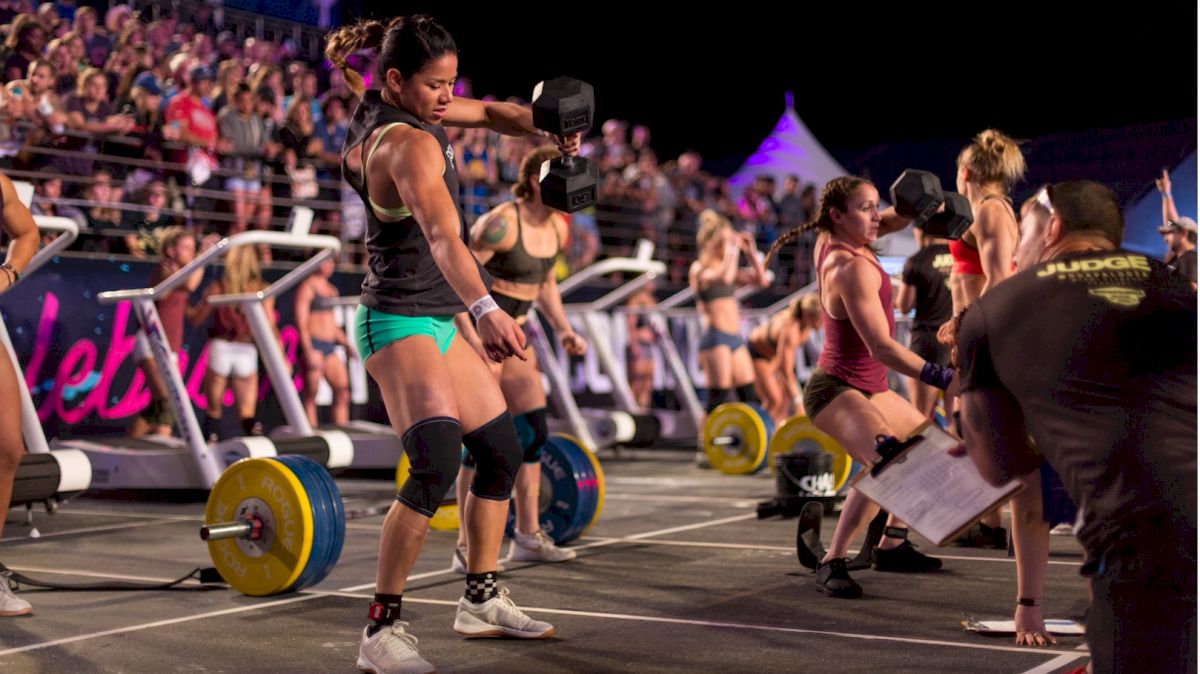CrossFit Games Open 18.1 Strategy By TZ Strength
CrossFit Games Open 18.1 Strategy By TZ Strength
Here is a breakdown of 18.1 including analyzing Sam Briggs' performance, a useful strategy for everyone, and a full warmup.

The vindication of a four-mile run in the Open continues to elude us all. Still, four weeks remain! In the meantime, let’s talk strategy for the first workout of the 2018 CrossFit Games Season.
18.1 is:
AMRAP 20
8 toes to bar
10 dumbbell clean & jerks (50/35, must be done 5 on one side and 5 on the other)
14/12 calorie row
(Editor's Note: This year's Open tips, trick, and strategy will be written by TZ Strength's Jacob Tsypkin. He has coached a bunch of Games athletes and he knows a thing or two, so listen up.)
Analysis & Output Management
I chose to track Briggs during this workout, as I expected her to be very consistent. She delivered the goods.
Here’s how it broke down:
Round | Toes-to-Bar | Clean and Jerk | Row |
1 | 0:11 | 0:30 | 0:41 |
2 | 0:16 | 0:30 | 0:45 |
3 | 0:13 | 0:26 | 0:44 |
4 | 0:15 | 0:28 | 0:46 |
5 | 0:14 | 0:26 | 0:44 |
6 | 0:14 | 0:28 | 0:43 |
7 | 0:14 | 0:29 | 0:45 |
8 | 0:16 | 0:29 | 0:46 |
9 | 0:15 | 0:29 | 0:46 |
10 | 0:13 | 0:28 | 0:44 |
11 | 0:19 | 0:28 | 0:44 |
12 | 0:14 | 0:28 | 0:41 |
13 | 0:17 | 0:28 | 0:41 |
14 | 0:16 | 0:31 | – |
Mean | 0:14.8 | 0:28.4 | 0:43.8 |
Notes:
Split times for each movement are taken when the athlete completes each set. Transitions are therefore accounted for at the beginning of each movement. i.e. the time for the row includes the time it takes the athlete to set down the dumbbell and get into the rower.
This is all hand timed and imperfect, but sufficient for our purposes.
This is mostly as expected — Briggs started out at a slightly faster pace than what she would end up averaging, and kicked towards the end, particularly on the row. But there are a few important takeaways.
First, it’s important to understand that the higher your level of overall fitness, the more the row will be the major determinant of your placement. High-level athletes will not break either of the other movements, and you can see from Briggs times, the combination of the toes-to-bar and the clean and jerk take up roughly as much time per round as the row on its own.
For elite male athletes, I suspect that the row will (despite the added calories) will be a bit faster than for the women, but I think it is likely to be the determining factor nonetheless. This is due largely to the fact that there isn’t much room to make up time on the other movements: if you’re already going unbroken, differences in cycle time are fairly marginal. But you can always row harder.
As you seek to determine your approach, you will want to have a good idea of the highest pace you can hold on the rower without sacrificing your ability to stay unbroken, or close to unbroken, on the other two movements.
How close is “close to unbroken”?
My recommendation is that if you do need to break somewhere, the toes-to-bar are a significantly better time to do it than the clean and jerk. This is because breaking the dumbbell clean and jerk will require you to set down and pick up the dumbbell, which is going to be more fatiguing and (generally) more psychologically difficult than hopping back up on the bar. The toes-to-bar will also be more fatiguing to the grip, so if you’re going to break, that’s the place to do it.
If you do break sets anywhere, remember: being strict with your rests can quite literally be a difference of a hundred spots on the leaderboard. As you formulate your plan, decide exactly how long your breaks will be, and then stick to that number — on the clock, not in your head. Your head will lie to you about what five seconds is. If you find that you need to increase the duration of your rests during the workout, that’s fine. Simply decide how much you want to increase by, and increase by that much — on the clock, not in your head.
Technical Considerations
Toes-to-bar: Not much here other than remembering not to death-grip the bar. Keep a relaxed grip that doesn’t cause undue fatigue.
Clean and jerk: This is a movement which will seriously reward a bit of practice. You want to find the sweet spot at the bottom where you can get a bit of a rebound off of your hamstrings, without going so low as to needlessly tire your back or increase your cycle time. You could see Briggs’ comfort with the movement increase after a couple of rounds, and it’s reflected in her times, with the third round clocking in four seconds faster than the first and second. The warmup below will include ample reps to make sure you get the chance to feel this movement out.
Beware the bicep curl. Your guns probably aren’t as big or as dense, mitochondrially speaking, as Briggs’ are, and while some bicep fatigue is inevitable with this movement, it will be to your benefit to allay it as much as possible. This means making sure to get adequate leg drive on every clean, and not taking over early with the arm. Dipping under to catch is optional — the weight is quite light, and a muscle clean is probably fine, so long as you make sure that your legs do the bulk of the work. Same goes for the jerk/shoulder-to-overhead — you can probably get away with push pressing, or just a very slight re-bend to get under, but don’t be lazy with your legs!
Row: It’s always important to row in a way which makes minimal use of the arms and maximal use of the legs. It is even more important in a workout where your arms just won’t get a break. Keep a loose, relaxed grip and try to “hang” from the handle. Holding your pace on the row is already going to be the hardest part of the workout — don’t make it harder by fatiguing your grip, which will impact every movement in this event.
Other Notes
Setup: Nothing particularly fancy here, just be sure to set up in a way which allows for smooth transitions and easy filming. The further away your rower is from your pull-up bar and your pull up bar from your dumbbell, the more opportunities you will give yourself to expand your rests more than you need to. There are a good few transitions in this workout — make them fast!
As always: Read the standards. Read them again. Watch the videos. If they’re relevant for you, make sure you fully understand the filming standards and make sure that you have a time established at your gym where you can expect to perform the workout uninterrupted. Don’t force yourself into an unnecessary redo because you didn’t do your homework.
Here’s to your best Open yet in 2018!
Warmup
Note: This is only the part of the warmup which is specific to the Open workout. It should not replace your normal general warmup routine.
Row 1500m. Start at a very easy pace, gradually increase as you warm-up. Don’t push it, just get moving.
3 Rounds:
10 Dumbbell Hang Power Clean & Jerk (5/side), build weight to RX
10 Hollow Rocks + 0:15 Hollow Hold
0:15 Static Hang from Pullup Bar + 3 Hanging Leg Raise, slow eccentric
EMOM 15, alternating:
2-6 Toes-to-Bar (start at 2, add a rep each round)
4-8 Dumbbell Hang Power Clean & Jerk (start with 2/side, add 1/side each round)
0:30 Row (build pace each round, for the last 2 rounds you should be holding approximately your target pace for the workout)
Jacob Tsypkin is the owner of TZ Strength. He began CrossFit in 2005, owned a gym for seven years, and switched to programming and remote coaching full time in 2014, after realizing he was just truly bad at mopping floors. In his free time, Jacob can be found battling fellow wizards at Magic: The Gathering, pontificating at the intersection of epistemology, ethics, sport, and training on his blog Exercise Philosophy, or practicing his Pajama Fighting in preparation for his final battle with Armen.
